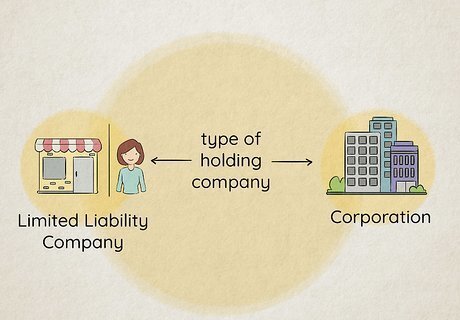
views
Creating Your Holding and Operating Companies

Assess your business needs. A holding company is an incorporated business that holds investments in other companies, called operating companies. The holding company does not perform any business activities other than borrowing, lending, and making investment decisions. However, the holding company loans funds or leases assets to an operating company that performs any kind of business activities. The two most common benefits of a holding company are tax reduction and asset protection. A holding company may provide a reduced tax rate by incorporating in a state with a more favorable tax structure, or it may protect company assets from loss to creditors of the operating company. Before forming a holding company you should consider your business needs and the benefits you want to achieve. A famous holding company in the US is Warren Buffett's Berkshire Hathaway. Berkshire Hathaway is a holding company that lends to and invests in operating companies, including GEICO and Coke. The holding company can borrow at lower rates than other businesses because it has ownership in such a diverse group of businesses. At the same time, the business profits greatly from the increase in the stock value of businesses it invests in. A holding company may also be suited for the owner of a small business, as the holding company can provide asset protection for the high value assets of the operating company. In this way, by forming a holding and operating company, a single person can protect both their personal and business high value assets from creditors of the operations of the business.

Determine your business structure. There are two predominate forms for a holding company, the corporation and the Limited Liability Company or LLC. You should determine which form fits your needs, as the form you choose may affect your taxes and liability. Most small business owners choose to form an LLC holding company, as the corporation structure generally do not provide the same asset protection. Consider what type of company you already have, if any, and what form of holding and operations company will suit your needs. If you are seeking a more favorable tax structure, you may consider forming your holding company in a separate state than the operating company. You should consult a business attorney for help setting up a company in another state. To maximize asset protection, you can form two LLCs, one holding and one operating company. You must create a separate entity for each, but the agent for each can be the same person - you. As long as you maintain the holding and operating companies as separate legal entities, the holding company will not be liable for debts of the operating company.

File a business application. You will form your holding company according to the state laws and the type of business you want to form. Whether you form an LLC or corporation, you will need to file registration with the state by giving the name of the business, the name of the business agent, and the articles of incorporation for your company. You should do this for your operating company as well as your holding company if your operating company is not already incorporated. Your articles of incorporation should state the purpose of your company and its objective, the names of the officers of the company, and how business decisions will be made. Update the articles of incorporation as you make business changes.

Create a bank account specific to your holding company. To maintain independence as separate companies, the holding company and the operating company must maintain separate bank accounts and accounting records. You should open a business account specific to your holding company by providing your new company tax ID when you create the account. Deposit all of the funds you will use to

Fund the holding company. To start using the holding company, you should fund the company to start investing in the operating company. The wealth of your companies should be stored in the holding company, and you can loan money to the operating company to fund operations as needed. If your operating company was already started before the holding company, start by selling all of the valuable assets of the operating company (such as land, buildings, large equipment, intellectual property, etc) to the holding company by filing a transfer of assets.

Keep accounting records for your transactions. As you operate your operating and holding companies, maintain accurate accounting records of the transactions that take place between your businesses. Separate accounting records are critical to maintaining legal distinction between the entities. The holding company must claim income for amounts it earns from the holding company in lease or rent revenue, so much as that amount exceeds the expense of owning the asset. You should keep records so that at the end of the year, you can account for all transfers that took place between your holding and operating companies.
Operating Your Holding and Operating Companies

Perform all operating activities through the operating company. Business activities are categorized as either operating, investing, or financing activities, and you must perform all operating activities through your operating company, not through your holding company. Operating activities are the sale of goods and services that drive revenue in a business, like the sale of groceries or clothing, or the sale of services such as dental work or carpet cleaning. To ensure that your holding company is never liable to creditors of the operating company, the holding company must never be involved in these operating activities. The phrase “piercing the corporate veil” is commonly used to describe when a holding company is held liable for the debts of an operating entity. This happens when the operations of the two companies are so intertwined, the holding company is held responsible to pay for the debts of the operating company. All employees who perform operating functions should be employees of the operating company, and should be paid using the operating company funds.

Invest and finance using the holding company. The holding company can act as a lender or lessor to the operating company, so that the holding company owns the business’ assets, and the operating company leases them from the holding company. Each month the operating company will pay lease expense to the holding company, providing cash flow back to the holding company. The holding company may also own land and charge rent to the operating company to use it, or loan money to the operating company and collect interest payments. You should aim to have most of the cash between the businesses stored with the holding company, where it can earn interest, and loan to the operating company when necessary. So long as the cash is on the holding company accounts, it is not subject to liabilities of the operating company. Many holding companies invest in multiple businesses, by owning stocks in multiple businesses and securing low interest using the financial security of the diverse investment. The holding company earns income on the investment growth in the smaller companies, as well as any interest or lease revenue it earns. Remember to always maintain separate bank accounts and records for each of the companies, so that you can track your activity and report on it.

File taxes and pay franchise fees. You will file two separate tax returns, one for the holding and one for the operating company. File your taxes annually, consult an accountant if you need to. You may also be required to pay state franchise fees for your companies, as well as filing any necessary reports with state business registries. Consult a business attorney if you are unsure what taxes and fees apply to your businesses.




















Comments
0 comment